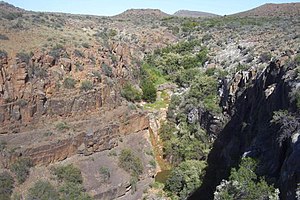The Karoo National Park is just west of Beaufort West in South Africa. This semi-desert area covers an area of 750 km² (290 sq mi). It is a sanctuary for herds of springbok, Oryx, zebra, buffalo, hartebeest, rhinoceros, eland, kudu, klipspringer, bat-eared foxes, black-backed jackal, ostriches, and lions. It also has the greatest number of tortoise species of any park in the world - five in total.
Understand
editHistory
editLandscape
editFlora and fauna
edit
- While birding on the plains route, larks and chats are prominent. Karoo Korhaan, Ludwig’s Bustard and Namaqua Sandgrouse should also be looked for. The park’s best birding occurs in and around the campsite. Acacia Pied Barbet, Red-eyed Bulbul, Karoo Scrub Robin, Cape Robin-chat, Chestnut-vented Tit-babbler, Layard’s Tit-babbler, Yellow-bellied Eremomola, Pale-winged Starling, Southern (Lesser) Double-collared and Dusky Sunbird and Redheaded Finch are all ever present. Karoo Eremomela, Namaqua Warbler (Prinia) and Pririt Batis are regional specials to be looked out for. Raptors to look out for include Booted Eagle, Pale Chanting Goshawk, Rock Kestrel and large numbers of Lesser Kestrel in summer. The park also has a high concentration of Verreaux’s (Black) Eagle.
- Because of the sparse vegetation, game viewing in Karoo National Park is very easy. Best viewing is achieved on the 13 km “Lammertjiesleegte” Route on the plains. Large herbivores such as Red Hartebeest, Eland, the two zebra species, kudu and springbok are all regularly seen. Klipspringer are regularly seen on the pass of the same name. Other species are less obvious due to smaller size, nocturnal habits or restriction to the wilderness areas of the park.
- Karoo National Park has a very rich reptilian fauna. Of particular significance are the 5 species of tortoise. However there is also a terrapin, an agama, 2 chameleons, a monitor, 18 snakes and several geckos, skinks and lizards.
- The vegetation in the Karoo National Park falls within the Karoo-Namib bio-geographical region, with areas of the park falling into the Nama Karoo Biome. The vegetation physiognomy consists of Montane Karoo grassy shrublands, Karoo grassy dwarf shrublands, Karoo succulent dwarf shrublands, and riparian thicket. Steep elevation and precipitation gradients have a direct impact on gradients in vegetation. High elevation (1800m) and relatively high rainfall (406mm) montane grasslands occupy communities dominated by grasses. The increasing aridity away from the escarpment edge is steep, and Motane Karoo dwarf shrublands replace these mesic communities. At lower elevation (800m) the precipitation is very low (175mm) and uncertain. The substrata influence the vegetation, with the sandy substrata of the drainage lines supporting more woody taxa and grasses. Moving away from the mesic environment of the riparian zone, rapid desiccation occurs and more xeric communities are encountered.
Climate
editGet in
editTake the N1 highway from Cape Town and drive for about 400 km, until you reach Beaufort West.
Fees
editValid to 31 October 2017:
- South African citizens and residents (with ID): R44 per adult, R22 per child, per day
- SADC nationals (with passport): R88 per adult, R44 per child, per day
- Foreign visitors: R176 per adult, R88 per child, per day
Get around
editThe park can be viewed by visitors on their own or with a guide.
The main roads are tarred. Some of the passes are not for the faint-hearted. There are nice 4x4 routes.
There are two main game viewing drives that do not require a four-wheel drive vehicle: the one to the east remains on the “Lammertjiesleegte” plains of the Lower Karoo; the other is the 49-km-long circular route to the west which ascends the Klipspringer Pass on to the plateau (Upper Karoo), and eventually returns to the plains at the "Doornhoek" picnic site at the western extremity of the loop. From there it follows a south-easterly course across the plains to the beginning of the Klipspringer Pass, near the camp site and chalets. At the top of the Klipspringer Pass the Rooivalle View Point presents a magnificent panorama of the Lower Karoo. The middle portion of the park, to the west of the Klipspringer Pass circular route, is easily accessible in 4x4 vehicles, and covers an extensive area, with rewarding game viewing opportunities.
See
edit- A large collection of fossils, dating back many millions of years
- Interpretive Centre
Do
edit- A bird hide
Buy
edit- Shop where curios and basic commodities may be purchased between 07:30-20:00.
Eat
edit- Fully licensed a la carte restaurant which is open for breakfast and dinner from 07:00-10:00 and 18:00-21:00.
- Picnic, braai and ablution facilities for day visitors at Bulkraal picnic site.
Doornhoek picnic site in the game viewing area.
Drink
editSleep
editStay safe
editGo next
edit
